Consumer Behavior: A Case Study of Great Eastern Women's Run Singapore
VerifiedAdded on 2021/04/24
|6
|1406
|87
Essay
AI Summary
This essay delves into the consumer behavior patterns observed within the Great Eastern Women's Run Singapore, framing it as a consumer community. It examines how the run fosters a sense of community, identity, and shared values among participants. The analysis draws upon consumer culture theory, exploring the symbolic meanings associated with the event and its branding, particularly the significance of the color red and the charitable causes it supports. The study highlights how participants form social networks, express their identities through the event, and extend their engagement beyond the run through social media platforms. The essay concludes by emphasizing the role of symbolic consumption and how the Great Eastern Women's Run serves as a platform for women to address common issues and develop a consumer identity that extends beyond the initial event, ultimately playing a broader consumer role in society.
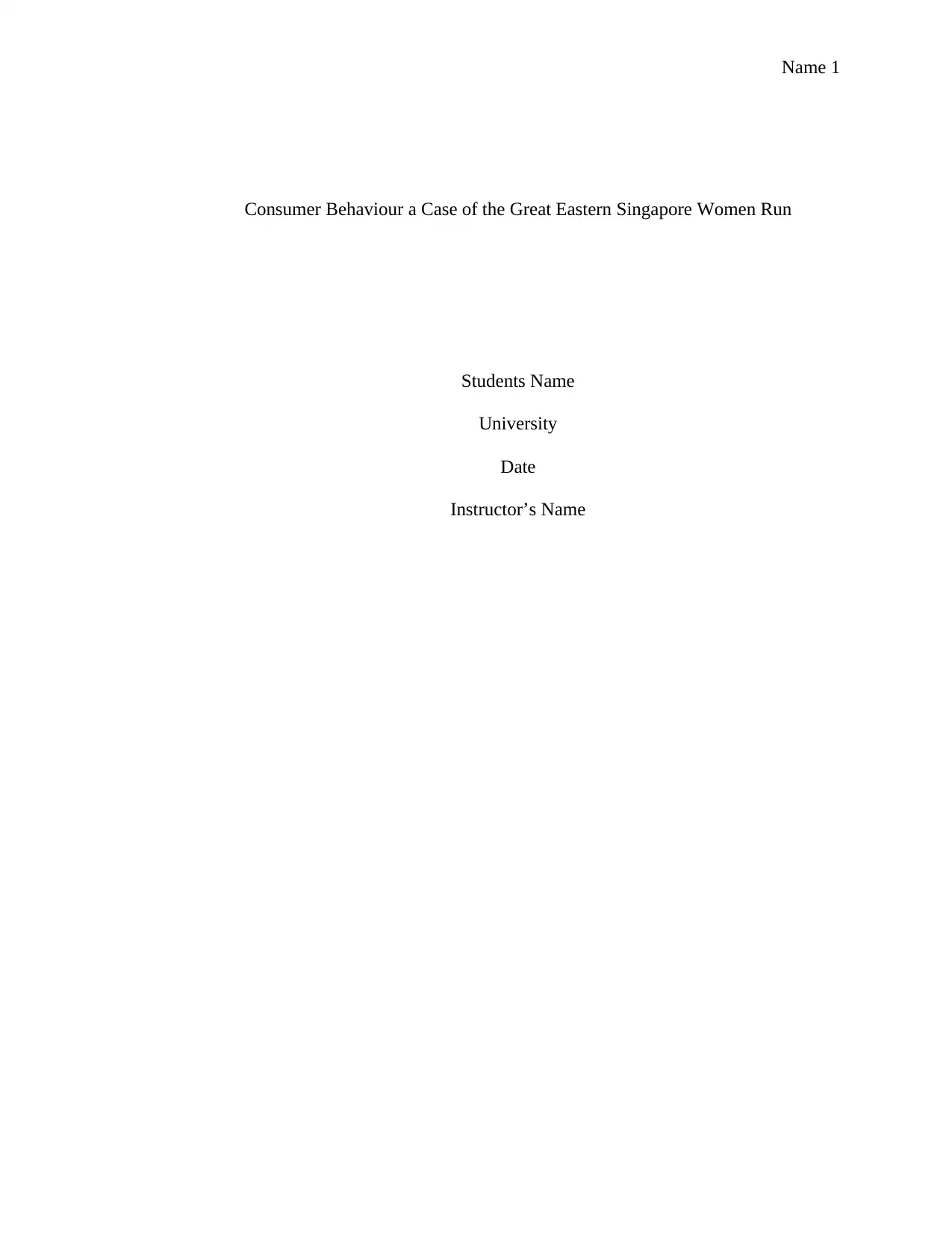
Name 1
Consumer Behaviour a Case of the Great Eastern Singapore Women Run
Students Name
University
Date
Instructor’s Name
Consumer Behaviour a Case of the Great Eastern Singapore Women Run
Students Name
University
Date
Instructor’s Name
Paraphrase This Document
Need a fresh take? Get an instant paraphrase of this document with our AI Paraphraser
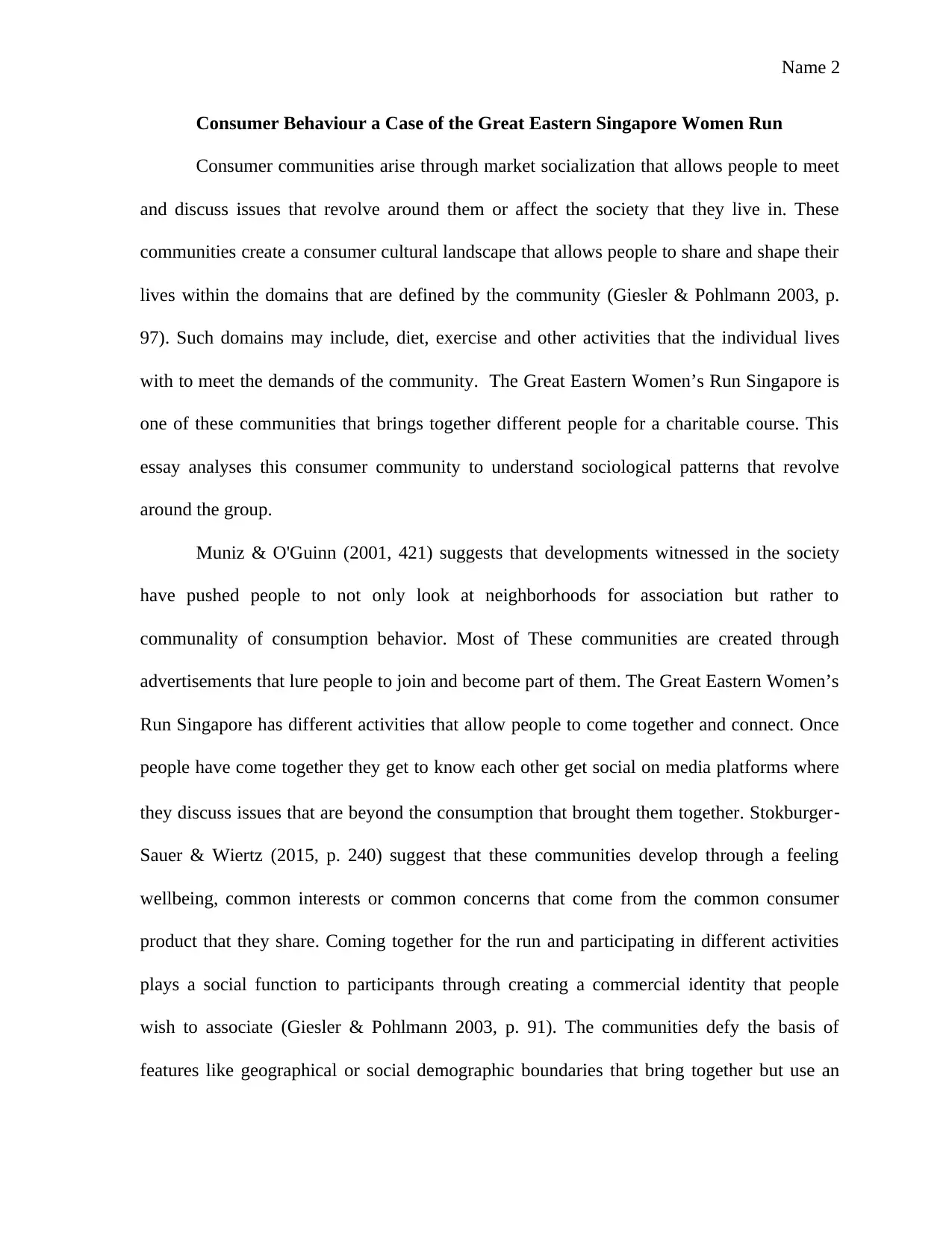
Name 2
Consumer Behaviour a Case of the Great Eastern Singapore Women Run
Consumer communities arise through market socialization that allows people to meet
and discuss issues that revolve around them or affect the society that they live in. These
communities create a consumer cultural landscape that allows people to share and shape their
lives within the domains that are defined by the community (Giesler & Pohlmann 2003, p.
97). Such domains may include, diet, exercise and other activities that the individual lives
with to meet the demands of the community. The Great Eastern Women’s Run Singapore is
one of these communities that brings together different people for a charitable course. This
essay analyses this consumer community to understand sociological patterns that revolve
around the group.
Muniz & O'Guinn (2001, 421) suggests that developments witnessed in the society
have pushed people to not only look at neighborhoods for association but rather to
communality of consumption behavior. Most of These communities are created through
advertisements that lure people to join and become part of them. The Great Eastern Women’s
Run Singapore has different activities that allow people to come together and connect. Once
people have come together they get to know each other get social on media platforms where
they discuss issues that are beyond the consumption that brought them together. Stokburger‐
Sauer & Wiertz (2015, p. 240) suggest that these communities develop through a feeling
wellbeing, common interests or common concerns that come from the common consumer
product that they share. Coming together for the run and participating in different activities
plays a social function to participants through creating a commercial identity that people
wish to associate (Giesler & Pohlmann 2003, p. 91). The communities defy the basis of
features like geographical or social demographic boundaries that bring together but use an
Consumer Behaviour a Case of the Great Eastern Singapore Women Run
Consumer communities arise through market socialization that allows people to meet
and discuss issues that revolve around them or affect the society that they live in. These
communities create a consumer cultural landscape that allows people to share and shape their
lives within the domains that are defined by the community (Giesler & Pohlmann 2003, p.
97). Such domains may include, diet, exercise and other activities that the individual lives
with to meet the demands of the community. The Great Eastern Women’s Run Singapore is
one of these communities that brings together different people for a charitable course. This
essay analyses this consumer community to understand sociological patterns that revolve
around the group.
Muniz & O'Guinn (2001, 421) suggests that developments witnessed in the society
have pushed people to not only look at neighborhoods for association but rather to
communality of consumption behavior. Most of These communities are created through
advertisements that lure people to join and become part of them. The Great Eastern Women’s
Run Singapore has different activities that allow people to come together and connect. Once
people have come together they get to know each other get social on media platforms where
they discuss issues that are beyond the consumption that brought them together. Stokburger‐
Sauer & Wiertz (2015, p. 240) suggest that these communities develop through a feeling
wellbeing, common interests or common concerns that come from the common consumer
product that they share. Coming together for the run and participating in different activities
plays a social function to participants through creating a commercial identity that people
wish to associate (Giesler & Pohlmann 2003, p. 91). The communities defy the basis of
features like geographical or social demographic boundaries that bring together but use an
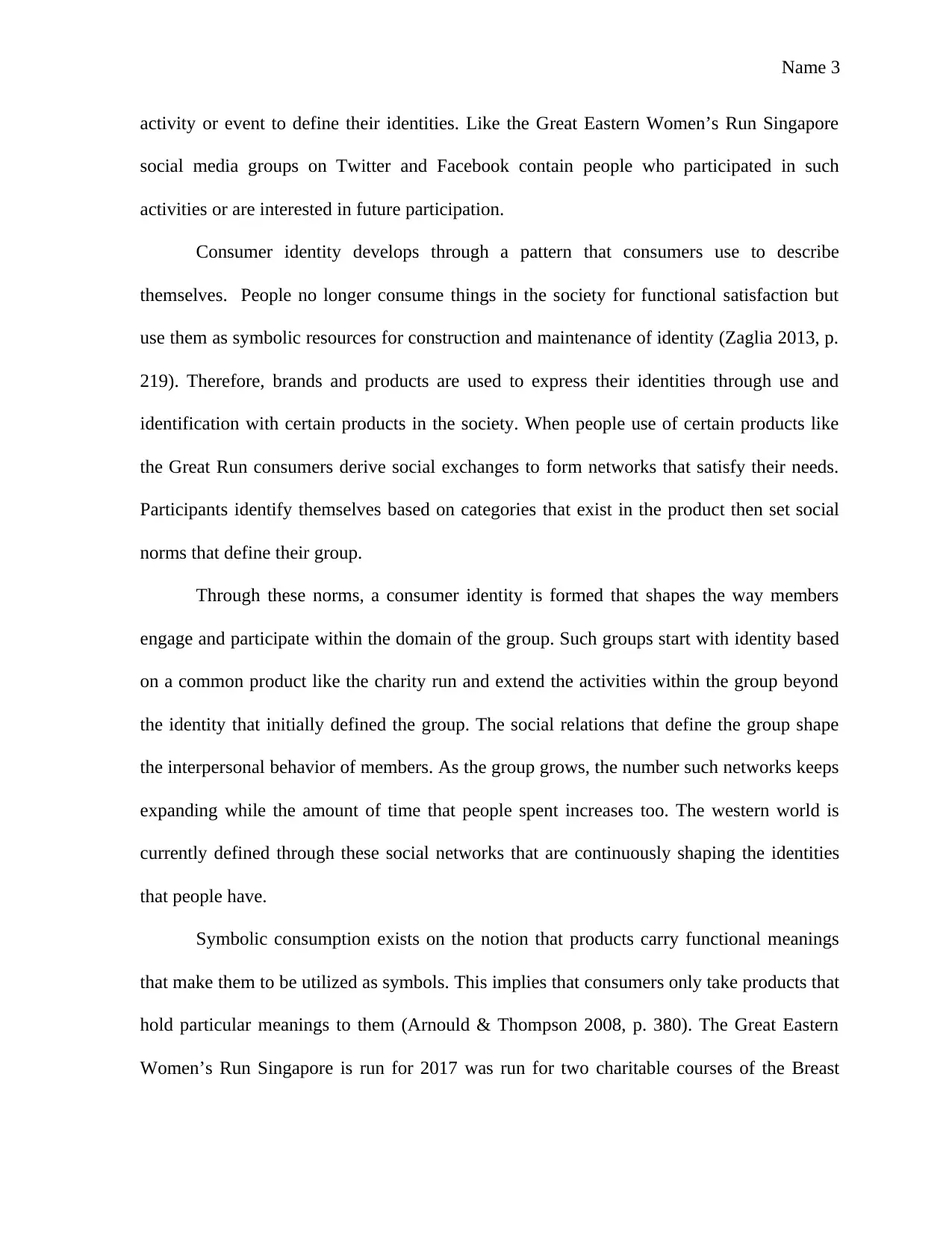
Name 3
activity or event to define their identities. Like the Great Eastern Women’s Run Singapore
social media groups on Twitter and Facebook contain people who participated in such
activities or are interested in future participation.
Consumer identity develops through a pattern that consumers use to describe
themselves. People no longer consume things in the society for functional satisfaction but
use them as symbolic resources for construction and maintenance of identity (Zaglia 2013, p.
219). Therefore, brands and products are used to express their identities through use and
identification with certain products in the society. When people use of certain products like
the Great Run consumers derive social exchanges to form networks that satisfy their needs.
Participants identify themselves based on categories that exist in the product then set social
norms that define their group.
Through these norms, a consumer identity is formed that shapes the way members
engage and participate within the domain of the group. Such groups start with identity based
on a common product like the charity run and extend the activities within the group beyond
the identity that initially defined the group. The social relations that define the group shape
the interpersonal behavior of members. As the group grows, the number such networks keeps
expanding while the amount of time that people spent increases too. The western world is
currently defined through these social networks that are continuously shaping the identities
that people have.
Symbolic consumption exists on the notion that products carry functional meanings
that make them to be utilized as symbols. This implies that consumers only take products that
hold particular meanings to them (Arnould & Thompson 2008, p. 380). The Great Eastern
Women’s Run Singapore is run for 2017 was run for two charitable courses of the Breast
activity or event to define their identities. Like the Great Eastern Women’s Run Singapore
social media groups on Twitter and Facebook contain people who participated in such
activities or are interested in future participation.
Consumer identity develops through a pattern that consumers use to describe
themselves. People no longer consume things in the society for functional satisfaction but
use them as symbolic resources for construction and maintenance of identity (Zaglia 2013, p.
219). Therefore, brands and products are used to express their identities through use and
identification with certain products in the society. When people use of certain products like
the Great Run consumers derive social exchanges to form networks that satisfy their needs.
Participants identify themselves based on categories that exist in the product then set social
norms that define their group.
Through these norms, a consumer identity is formed that shapes the way members
engage and participate within the domain of the group. Such groups start with identity based
on a common product like the charity run and extend the activities within the group beyond
the identity that initially defined the group. The social relations that define the group shape
the interpersonal behavior of members. As the group grows, the number such networks keeps
expanding while the amount of time that people spent increases too. The western world is
currently defined through these social networks that are continuously shaping the identities
that people have.
Symbolic consumption exists on the notion that products carry functional meanings
that make them to be utilized as symbols. This implies that consumers only take products that
hold particular meanings to them (Arnould & Thompson 2008, p. 380). The Great Eastern
Women’s Run Singapore is run for 2017 was run for two charitable courses of the Breast
⊘ This is a preview!⊘
Do you want full access?
Subscribe today to unlock all pages.

Trusted by 1+ million students worldwide
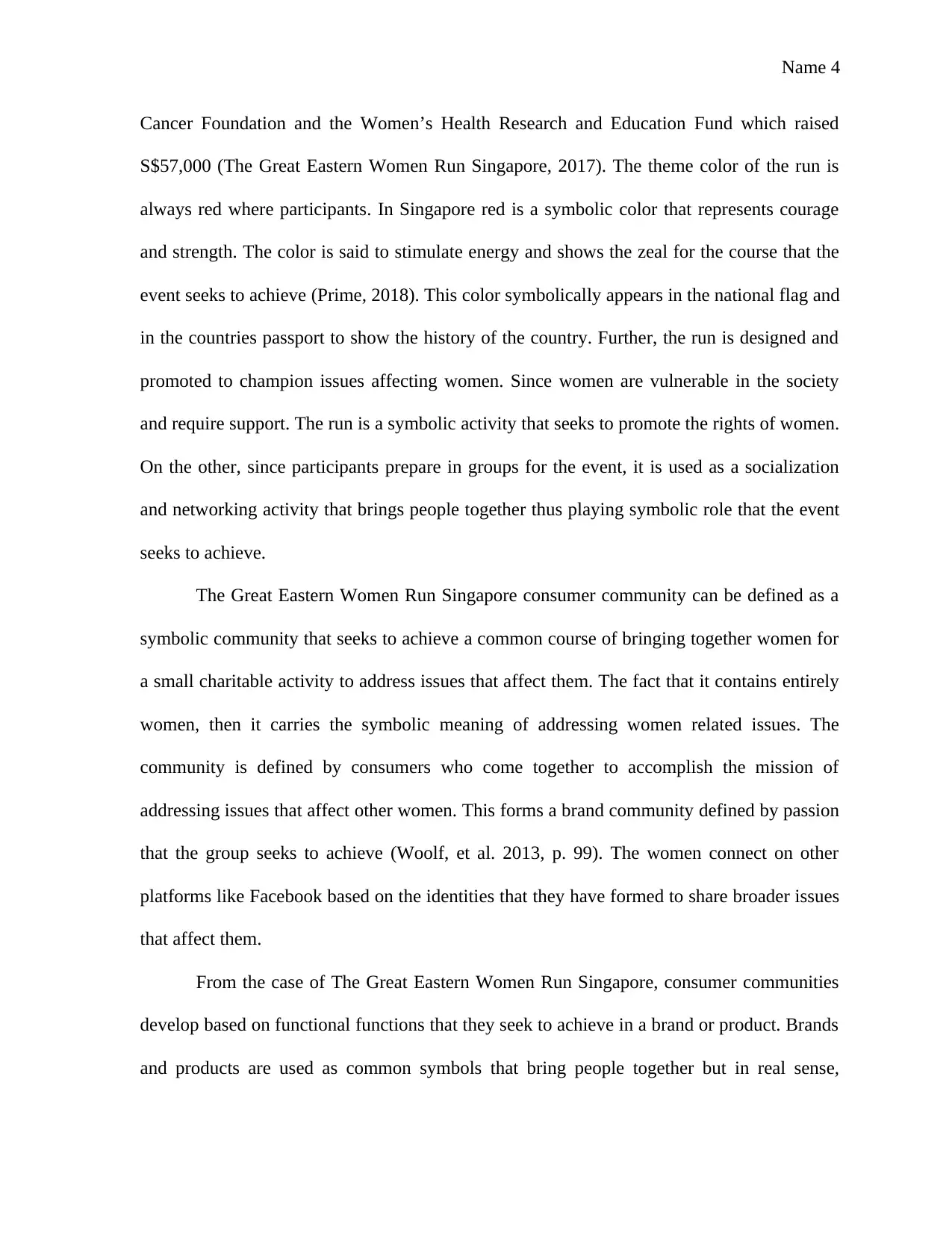
Name 4
Cancer Foundation and the Women’s Health Research and Education Fund which raised
S$57,000 (The Great Eastern Women Run Singapore, 2017). The theme color of the run is
always red where participants. In Singapore red is a symbolic color that represents courage
and strength. The color is said to stimulate energy and shows the zeal for the course that the
event seeks to achieve (Prime, 2018). This color symbolically appears in the national flag and
in the countries passport to show the history of the country. Further, the run is designed and
promoted to champion issues affecting women. Since women are vulnerable in the society
and require support. The run is a symbolic activity that seeks to promote the rights of women.
On the other, since participants prepare in groups for the event, it is used as a socialization
and networking activity that brings people together thus playing symbolic role that the event
seeks to achieve.
The Great Eastern Women Run Singapore consumer community can be defined as a
symbolic community that seeks to achieve a common course of bringing together women for
a small charitable activity to address issues that affect them. The fact that it contains entirely
women, then it carries the symbolic meaning of addressing women related issues. The
community is defined by consumers who come together to accomplish the mission of
addressing issues that affect other women. This forms a brand community defined by passion
that the group seeks to achieve (Woolf, et al. 2013, p. 99). The women connect on other
platforms like Facebook based on the identities that they have formed to share broader issues
that affect them.
From the case of The Great Eastern Women Run Singapore, consumer communities
develop based on functional functions that they seek to achieve in a brand or product. Brands
and products are used as common symbols that bring people together but in real sense,
Cancer Foundation and the Women’s Health Research and Education Fund which raised
S$57,000 (The Great Eastern Women Run Singapore, 2017). The theme color of the run is
always red where participants. In Singapore red is a symbolic color that represents courage
and strength. The color is said to stimulate energy and shows the zeal for the course that the
event seeks to achieve (Prime, 2018). This color symbolically appears in the national flag and
in the countries passport to show the history of the country. Further, the run is designed and
promoted to champion issues affecting women. Since women are vulnerable in the society
and require support. The run is a symbolic activity that seeks to promote the rights of women.
On the other, since participants prepare in groups for the event, it is used as a socialization
and networking activity that brings people together thus playing symbolic role that the event
seeks to achieve.
The Great Eastern Women Run Singapore consumer community can be defined as a
symbolic community that seeks to achieve a common course of bringing together women for
a small charitable activity to address issues that affect them. The fact that it contains entirely
women, then it carries the symbolic meaning of addressing women related issues. The
community is defined by consumers who come together to accomplish the mission of
addressing issues that affect other women. This forms a brand community defined by passion
that the group seeks to achieve (Woolf, et al. 2013, p. 99). The women connect on other
platforms like Facebook based on the identities that they have formed to share broader issues
that affect them.
From the case of The Great Eastern Women Run Singapore, consumer communities
develop based on functional functions that they seek to achieve in a brand or product. Brands
and products are used as common symbols that bring people together but in real sense,
Paraphrase This Document
Need a fresh take? Get an instant paraphrase of this document with our AI Paraphraser
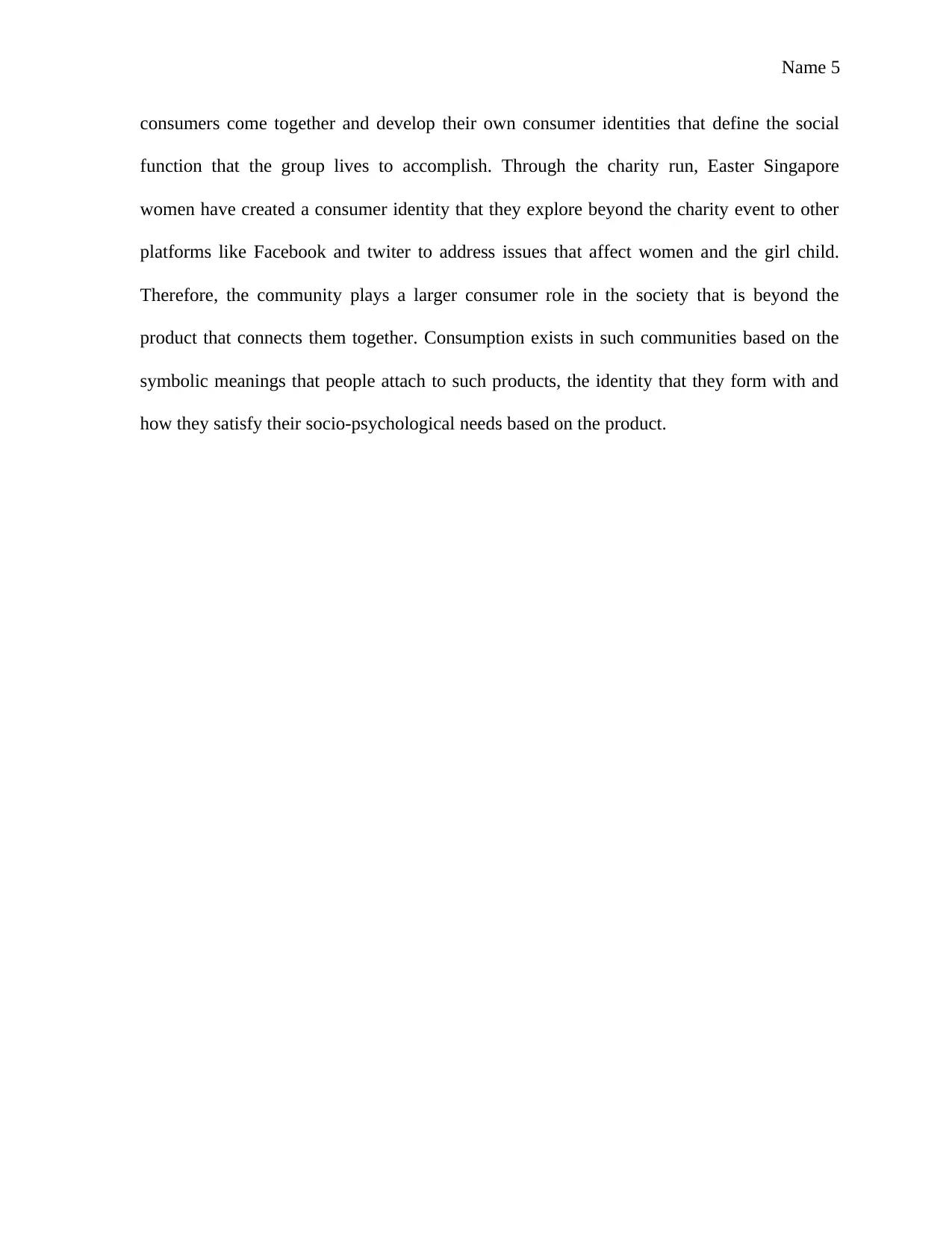
Name 5
consumers come together and develop their own consumer identities that define the social
function that the group lives to accomplish. Through the charity run, Easter Singapore
women have created a consumer identity that they explore beyond the charity event to other
platforms like Facebook and twiter to address issues that affect women and the girl child.
Therefore, the community plays a larger consumer role in the society that is beyond the
product that connects them together. Consumption exists in such communities based on the
symbolic meanings that people attach to such products, the identity that they form with and
how they satisfy their socio-psychological needs based on the product.
consumers come together and develop their own consumer identities that define the social
function that the group lives to accomplish. Through the charity run, Easter Singapore
women have created a consumer identity that they explore beyond the charity event to other
platforms like Facebook and twiter to address issues that affect women and the girl child.
Therefore, the community plays a larger consumer role in the society that is beyond the
product that connects them together. Consumption exists in such communities based on the
symbolic meanings that people attach to such products, the identity that they form with and
how they satisfy their socio-psychological needs based on the product.
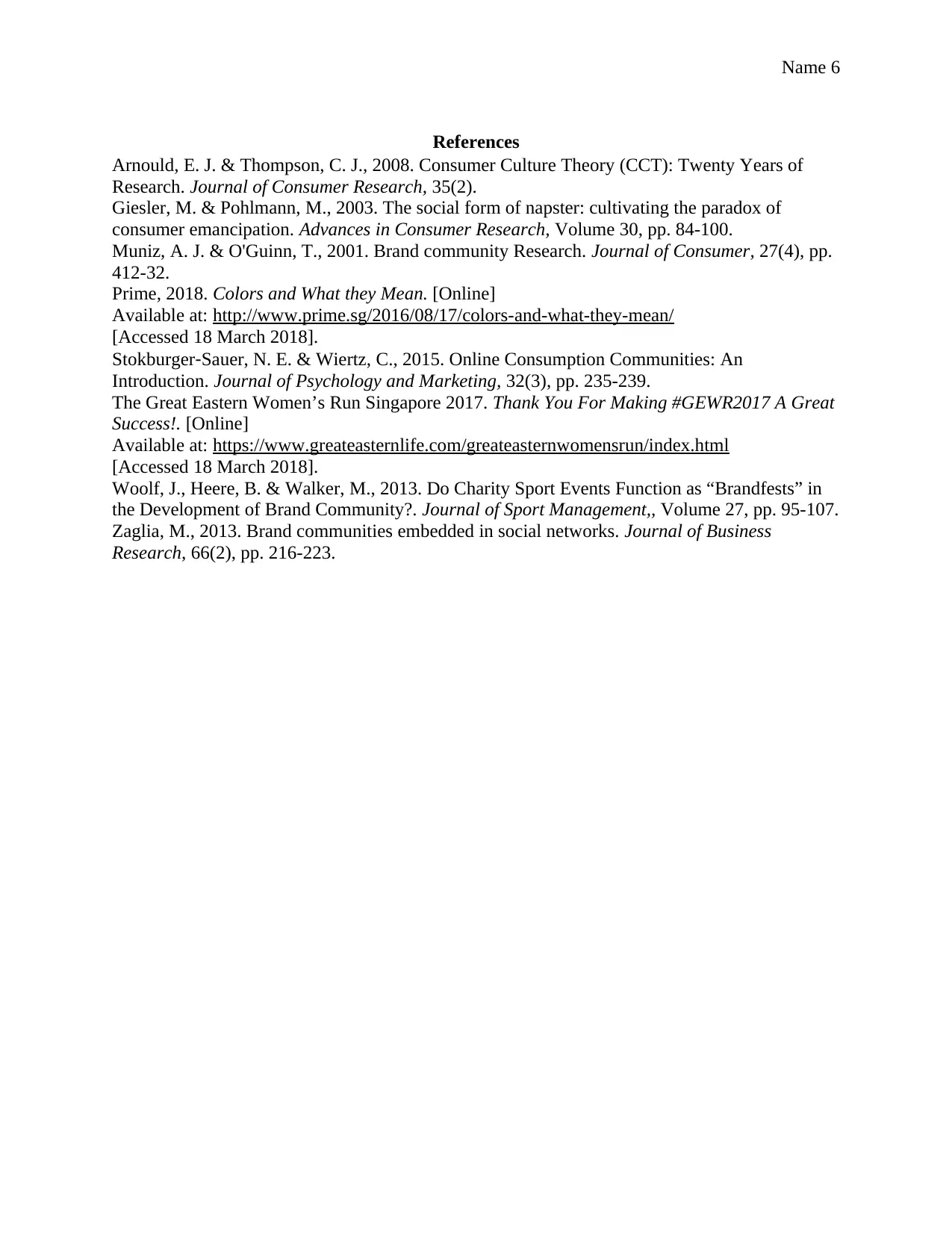
Name 6
References
Arnould, E. J. & Thompson, C. J., 2008. Consumer Culture Theory (CCT): Twenty Years of
Research. Journal of Consumer Research, 35(2).
Giesler, M. & Pohlmann, M., 2003. The social form of napster: cultivating the paradox of
consumer emancipation. Advances in Consumer Research, Volume 30, pp. 84-100.
Muniz, A. J. & O'Guinn, T., 2001. Brand community Research. Journal of Consumer, 27(4), pp.
412-32.
Prime, 2018. Colors and What they Mean. [Online]
Available at: http://www.prime.sg/2016/08/17/colors-and-what-they-mean/
[Accessed 18 March 2018].
Stokburger‐Sauer, N. E. & Wiertz, C., 2015. Online Consumption Communities: An
Introduction. Journal of Psychology and Marketing, 32(3), pp. 235-239.
The Great Eastern Women’s Run Singapore 2017. Thank You For Making #GEWR2017 A Great
Success!. [Online]
Available at: https://www.greateasternlife.com/greateasternwomensrun/index.html
[Accessed 18 March 2018].
Woolf, J., Heere, B. & Walker, M., 2013. Do Charity Sport Events Function as “Brandfests” in
the Development of Brand Community?. Journal of Sport Management,, Volume 27, pp. 95-107.
Zaglia, M., 2013. Brand communities embedded in social networks. Journal of Business
Research, 66(2), pp. 216-223.
References
Arnould, E. J. & Thompson, C. J., 2008. Consumer Culture Theory (CCT): Twenty Years of
Research. Journal of Consumer Research, 35(2).
Giesler, M. & Pohlmann, M., 2003. The social form of napster: cultivating the paradox of
consumer emancipation. Advances in Consumer Research, Volume 30, pp. 84-100.
Muniz, A. J. & O'Guinn, T., 2001. Brand community Research. Journal of Consumer, 27(4), pp.
412-32.
Prime, 2018. Colors and What they Mean. [Online]
Available at: http://www.prime.sg/2016/08/17/colors-and-what-they-mean/
[Accessed 18 March 2018].
Stokburger‐Sauer, N. E. & Wiertz, C., 2015. Online Consumption Communities: An
Introduction. Journal of Psychology and Marketing, 32(3), pp. 235-239.
The Great Eastern Women’s Run Singapore 2017. Thank You For Making #GEWR2017 A Great
Success!. [Online]
Available at: https://www.greateasternlife.com/greateasternwomensrun/index.html
[Accessed 18 March 2018].
Woolf, J., Heere, B. & Walker, M., 2013. Do Charity Sport Events Function as “Brandfests” in
the Development of Brand Community?. Journal of Sport Management,, Volume 27, pp. 95-107.
Zaglia, M., 2013. Brand communities embedded in social networks. Journal of Business
Research, 66(2), pp. 216-223.
⊘ This is a preview!⊘
Do you want full access?
Subscribe today to unlock all pages.

Trusted by 1+ million students worldwide
1 out of 6
Related Documents
Your All-in-One AI-Powered Toolkit for Academic Success.
+13062052269
info@desklib.com
Available 24*7 on WhatsApp / Email
![[object Object]](/_next/static/media/star-bottom.7253800d.svg)
Unlock your academic potential
Copyright © 2020–2025 A2Z Services. All Rights Reserved. Developed and managed by ZUCOL.





